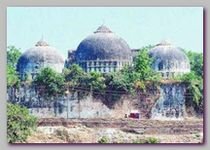– BABRI MOSQUE CRISIS
 0n 12/16/1992 a Hindu mob demolished to the ground the Babri Masjid (Mosque) in the Northern Indian town of Ayodhya in Uttar Pradesh State. The Babri Masjid (Mosque) was built in 1528 on a site where Hindus claimed 330 years later, in 1853, marks the spot where one of the most revered deities in Hinduism, Lord Rama, was born.
0n 12/16/1992 a Hindu mob demolished to the ground the Babri Masjid (Mosque) in the Northern Indian town of Ayodhya in Uttar Pradesh State. The Babri Masjid (Mosque) was built in 1528 on a site where Hindus claimed 330 years later, in 1853, marks the spot where one of the most revered deities in Hinduism, Lord Rama, was born.
In response to unrest in Ayodhya the British Colonial regime set up a compromised arrangement, in 1858, in which the inner court of Babri Mosque will be used by Muslims and the outer court by Hindus.
The independence of India in 1947 and the increasing tension between Muslims and Hindus  reflected also on the Babri Mosque ongoing crisis. In 1949 Lord Rama mysteriously appeared inside the Mosque, allegedly placed there by Hindus. Muslims protested, and both parties filed civil suits.
reflected also on the Babri Mosque ongoing crisis. In 1949 Lord Rama mysteriously appeared inside the Mosque, allegedly placed there by Hindus. Muslims protested, and both parties filed civil suits.
Hindus formed, in 1984, a committee to “liberate” the birth-place of Lord Rama and build a temple in his honor, spearheaded by the nationalist Vishwa Hindu Parishad party (VHP). The Babri Mosque crisis became a nation wide crisis in India refueled by extremists from both sides.
1986: District judge orders the gates of the disputed Mosque opened to allow Hindus to worship there. Muslims set up Babri Mosque Action Committee in protest.
1990: VHP volunteers partially damage the mosque. Prime Minister Chandra Shekhar tries to resolve the dispute through negotiations, which fail the next year.
12/16/1992: The mosque is torn down by supporters of the VHP, the Shiv Sena party prompting nationwide rioting between Hindus and Muslims in which more than 2,000 people died.
2001: Tensions rose on the anniversary of the demolition of the mosque. VHP pledges again to build Hindu temple on the site.
Jan 2002: Mr Vajpayee, India’s PM, set up an Ayodhya cell in his office and appointed a senior official, Shatrughna Singh, to hold talks with Hindu and Muslim leaders (see – Ayodhya Report).
Feb 2002: Hindu nationalist Bharatiya Janata Party (BJP) committed itself to the construction of a temple in its election manifesto for Uttar Pradesh assembly elections. VHP confirmed a deadline of 03/15/2002 to begin construction. Hundreds of volunteers converged on site. At least 58 people were killed in an attack, committed probably by Muslims, on a train in Godhra which was carrying Hindu activists returning from Ayodhya.
Mar 2002: Between 1,000 and 2,000 people, mostly Muslims, died in riots in Gujarat following the Godhra train attack.
Apr 2002: Three High Court judges began hearings on determining who owns the religious site.
Jan 2003: Archaeologists began a court-ordered survey to find out whether a temple to Lord Rama existed on the site.
Aug 2003: The survey brought some evidence of a temple beneath the mosque, but Muslims disputed the findings. Mr Vajpayee said at the funeral of Hindu activist Ramchandra Das Paramhans that he will fulfill the dying man’s wishes and build a temple at Ayodhya. However, he hoped the courts and negotiations will solve the issue.
Sept 2003: A court ruled that seven Hindu leaders should stand trial for inciting the destruction of the Babri Mosque, but no charges were brought against Mr Advani, deputy prime minister in 2005, who was also at the site in 1992.
Oct 2004: Mr Advani said his party still has “unwavering” commitment to building a temple at Ayodhya, which he said was “inevitable”.
Nov 2004: A court in Uttar Pradesh ruled that an earlier order, which exonerated Mr Advani for his role in the destruction of the Mosque, should be reviewed.
July 2005 Suspected Islamic militants attacked the disputed site, using a jeep laden with explosives to blow a hole in the wall of the complex. Security forces killed five people they said were militants, and a sixth who were not immediately identified.
Summary –
* The Babri Mosque crisis fueled Islamic militancy in India and caused many Indian Muslims to join Pakistani affiliated terror organizations or to create their own self made terror cells. Many were motivated by the desire to avenge the death of so many Muslims by Hindus.
* The state of Uttar Pradesh became an epicenter for Islamic radicalization, second to Kashmir, and the greenhouse for many Indian home grown terrorists such as SIMI or the INDIAN Mujahideen.
* The Lucknow bench of the Allahabad High Court issued, on Thursday 09/30/2010, the much anticipated ruling. The judges gave control of the main disputed section of the site, where a mosque was torn down in 1992, to Hindus. Other parts of the site will be controlled by Muslims and another Hindu sect. The Associated Press news agency quoted a lawyer for the Muslim community as saying he would appeal the ruling. A final decision could take years to emerge.
*****************************
Read more ;